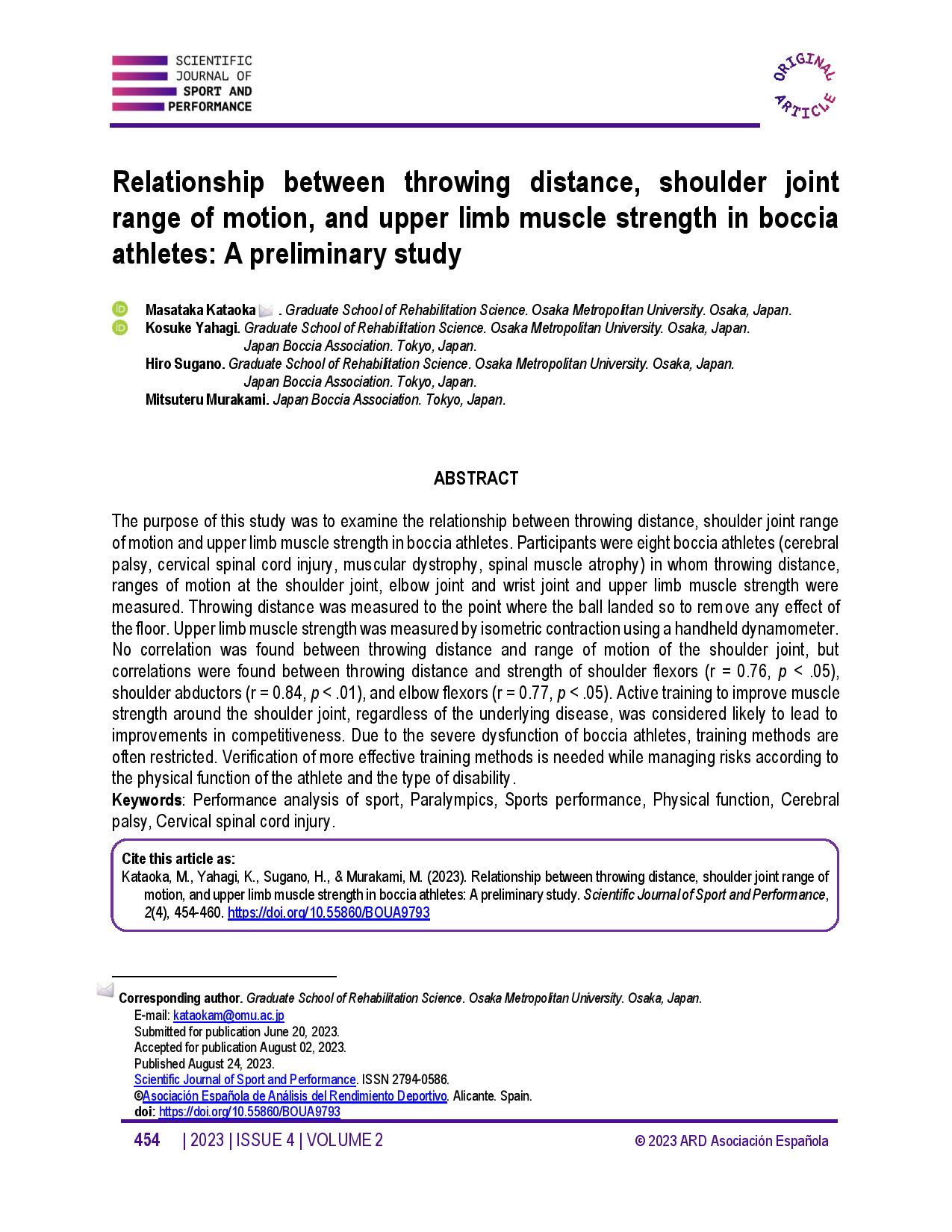Relationship between throwing distance, shoulder joint range of motion, and upper limb muscle strength in boccia athletes A preliminary study
Main Article Content
Abstract
The purpose of this study was to examine the relationship between throwing distance, shoulder joint range of motion and upper limb muscle strength in boccia athletes. Participants were eight boccia athletes (cerebral palsy, cervical spinal cord injury, muscular dystrophy, spinal muscle atrophy) in whom throwing distance, ranges of motion at the shoulder joint, elbow joint and wrist joint and upper limb muscle strength were measured. Throwing distance was measured to the point where the ball landed so to remove any effect of the floor. Upper limb muscle strength was measured by isometric contraction using a handheld dynamometer. No correlation was found between throwing distance and range of motion of the shoulder joint, but correlations were found between throwing distance and strength of shoulder flexors (r = 0.76, p < .05), shoulder abductors (r = 0.84, p < .01), and elbow flexors (r = 0.77, p < .05). Active training to improve muscle strength around the shoulder joint, regardless of the underlying disease, was considered likely to lead to improvements in competitiveness. Due to the severe dysfunction of boccia athletes, training methods are often restricted. Verification of more effective training methods is needed while managing risks according to the physical function of the athlete and the type of disability.
Article Details

This work is licensed under a Creative Commons Attribution-NonCommercial-ShareAlike 4.0 International License.
References
Andersson, C., Grooten, W., Hellsten, M., Kaping, K., & Mattsson, E. (2003). Adults with cerebral palsy: walking ability after progressive strength training. Dev Med Child Neurol, 45, 220-228. https://doi.org/10.1017/S0012162203000446 DOI: https://doi.org/10.1111/j.1469-8749.2003.tb00335.x
Cornejo, M. I., Roldan, A., & Reina, R. (2022). What is the relationship between trunk control function and arm coordination in adults with severe-to-moderate quadriplegic cerebral palsy?. Int J Environ Res Public Health, 20, 141. https://doi.org/10.3390/ijerph20010141 DOI: https://doi.org/10.3390/ijerph20010141
Damiano, D.L., Vaughan, C.L., & Abel, M.F. (1995). Muscle response to heavy resistance exercise in children with spastic cerebral palsy. Dev Med Child Neurol, 37, 731-739. https://doi.org/10.1111/j.1469-8749.1995.tb15019.x DOI: https://doi.org/10.1111/j.1469-8749.1995.tb15019.x
Dickson, M.J., Fuss, F.K., & Wong, K.G. (2010). Benchmarking of boccia balls: Roll distance, accuracy, stiffness, rolling friction, and coefficient of restitution. Sports Technol, 3, 131-140. https://doi.org/10.1080/19346182.2010.540474 DOI: https://doi.org/10.1080/19346182.2010.540474
Doewes, R. I., Elumalai, G., & Azmi, S. H. (2023). Gender differences in boccia underhand throw biomechanics. Acta Biomed, 94, 970-993.
Fong, D.T., Yam, K.Y., Chu, V.W., Cheung, R.T., & Chan, K.M. (2012). Upper limb muscle fatigue during prolonged Boccia games with underarm throwing technique. Sports Biomech, 11, 441-451. https://doi.org/10.1080/14763141.2012.699977 DOI: https://doi.org/10.1080/14763141.2012.699977
Huang, P.C., Pan P.J., Ou, Y.C., Yu, Y.C., & Tsai, Y.S. (2014). Motion analysis of throwing Boccia balls in children with cerebral palsy. Res Dev Disabil, 35, 441-451. https://doi.org/10.1016/j.ridd.2013.11.017 DOI: https://doi.org/10.1016/j.ridd.2013.11.017
Johann, P. K., & Patrick, K. (2019). Muscle activity in throwing with the dominant and non-dominant arm. Cogent Med, 6, 1678221. https://doi.org/10.1080/2331205X.2019.1678221 DOI: https://doi.org/10.1080/2331205X.2019.1678221
Kataoka, M., Okuda, K., Iwata, A., Imura, S., Yahagi, K., & Matsuo, Y. (2020). Throwing distance and competitive performance of Boccia players. J Phys Ther Sci, 32, 574-577. https://doi.org/10.1589/jpts.32.574 DOI: https://doi.org/10.1589/jpts.32.574
Lance, J. W. (1980). Symposium synopsis. Yearbook Medical, p.485-494.
Singh, D., Jaseja, H., & Pal, R. (2019). Biomechanical analysis of throwing techniques for velocity and accuracy. J Phys Edu Res, 6 (1), 13-23.
Tsai Y.S., Yu Y.C., Huang P.C., & Cheng H.Y. (2014). Seat surface inclination may affect postural stability during Boccia ball throwing in children with cerebral palsy. Res Dev Disabil, 35, 3568-3573. https://doi.org/10.1016/j.ridd.2014.08.033 DOI: https://doi.org/10.1016/j.ridd.2014.08.033
van den Tillaar, R., & Ettema, G. (2003). Influence of instruction on velocity and accuracy of overarm throwing. Percept Mot Skills, 96, 423-434. https://doi.org/10.2466/pms.2003.96.2.423 DOI: https://doi.org/10.2466/pms.2003.96.2.423




